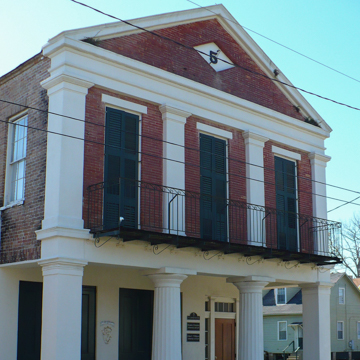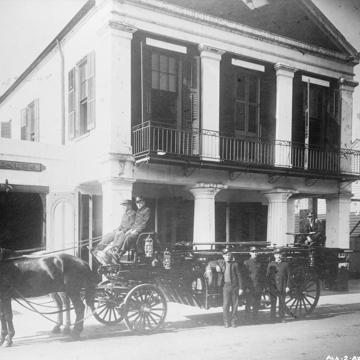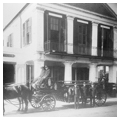You are here
Washington Firehouse No. 8
The Greek Revival wore many faces in Alabama, and one of its virtues was the ability to sometimes transform the utilitarian into the engaging. So it is with Mobile’s Firehouse No. 5 (now No. 8). Here, an otherwise plain, two-story brick building has acquired savoir faire through a robust applique of Grecian architectural elements to its narrow, three-bay facade. Below a triangular, gable-turned-pediment, a well-proportioned entablature and pilasters frame three tall, shuttered, second-floor windows that open onto a cantilevered wrought-iron balcony. This arrangement is, in turn, superimposed above a pair of sturdy Doric pillars in antis that screen a shady, street-level walkway. Originally, a pair of horse-drawn engines could quickly exit the firehouse from the two large portals behind. Through a door to one side, members of Washington Firehouse Company No. 5 could come and go either as dutiful volunteer firemen or occasional revelers in the spacious upstairs social hall.
In a city constructed largely of wood, fire was an ever-present concern. Indeed, major fires in 1827 and again in 1839, which claimed buildings like the mammoth United States Hotel, underscored the threat. By midcentury, some half-dozen volunteer companies existed to protect the city, all loosely organized under the umbrella Mobile Fire Department Association, which set rules and regulations. The companies functioned as social institutions as well, maintaining a friendly rivalry among themselves as participants in, if not sponsors of, a fun-loving community’s parades and picnics, soirees and dances.
Though organized in 1843, the Washington Fire Company did not complete its building until 1851, at a cost of $5,500. Clearly there was an eye to convivial gatherings as well as to utility. And members and guests attending social events in the lofty second-floor meeting hall could take the evening air by stepping outside through one of the floor-length windows that opened onto the long balcony overhanging the street. Besides Washington No. 5, the engine houses of two more of the city’s volunteer companies, the Phoenix and the Creole, still survive as well. The Italianate Phoenix No. 5 firehouse, dating from 1859, was dismantled, moved, and reconstructed as the city-owned Phoenix Fire Museum in the early 1960s, when the blocks around it were cleared for urban renewal. The Creole Company firehouse was built between 1869 and 1872 for what was actually Mobile’s oldest volunteer fire company, organized in the 1820s by members of the city’s free black community—mostly mixed-blood descendants of the Mobile’s early French, Spanish, and African population.
After a municipal fire department was established in 1888, the city of Mobile acquired Washington Firehouse No. 5 and designated it No. 8 Firehouse. By 1925, however, it had become obsolete. When documented for the Historical American Buildings Survey in the 1930s, the building stood derelict. Now adaptively restored as a legal offices, Washington Firehouse No. 5 was listed on the National Register of Historic Places in 1983.
References
Amos, Harriet E. Cotton City: Urban Development in Antebellum Mobile. Tuscaloosa: University of Alabama Press, 1985.
Gamble, Robert. The Alabama Catalog – Historic American Buildings Survey. A Guide to the Early Architecture of the State.Tuscaloosa: University of Alabama Press, 1987.
Sledge, John S. The Pillared City: Greek Revival Mobile.Athens: University of Georgia Press, 2009.
Writing Credits
If SAH Archipedia has been useful to you, please consider supporting it.
SAH Archipedia tells the story of the United States through its buildings, landscapes, and cities. This freely available resource empowers the public with authoritative knowledge that deepens their understanding and appreciation of the built environment. But the Society of Architectural Historians, which created SAH Archipedia with University of Virginia Press, needs your support to maintain the high-caliber research, writing, photography, cartography, editing, design, and programming that make SAH Archipedia a trusted online resource available to all who value the history of place, heritage tourism, and learning.

















